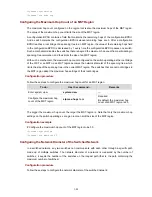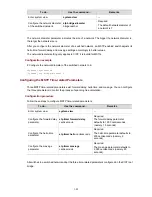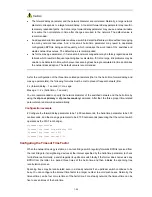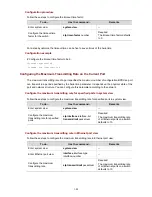
1-35
To do...
Use the command...
Remarks
Enter system view
system-view
—
Enable the BPDU guard
function
stp bpdu-protection
Required
The BPDU guard function is
disabled by default.
Configuration example
# Enable the BPDU guard function.
<Sysname> system-view
[Sysname] stp bpdu-protection
As Gigabit ports of a 3Com switch 4500 cannot be shut down, the BPDU guard function is not
applicable to these ports even if you enable the BPDU guard function and specify these ports to be
MSTP edge ports.
Configuring Root Guard
A root bridge and its secondary root bridges must reside in the same region. The root bridge of the CIST
and its secondary root bridges are usually located in the high-bandwidth core region. Configuration
errors or attacks may result in configuration BPDUs with their priorities higher than that of a root bridge,
which causes a new root bridge to be elected and network topology jitter to occur. In this case, flows that
should travel along high-speed links may be led to low-speed links, and network congestion may occur.
You can avoid this problem by utilizing the root guard function. Ports with this function enabled can only
be kept as designated ports in all MSTIs. When a port of this type receives configuration BPDUs with
higher priorities, it turns to the discarding state (rather than become a non-designated port) and stops
forwarding packets (as if it is disconnected from the link). It resumes the normal state if it does not
receive any configuration BPDUs with higher priorities for a specified period.
z
You are recommended to enable root guard on the designated ports of a root bridge.
z
Loop guard, root guard, and edge port settings are mutually exclusive. With one of these functions
enabled on a port, any of the other two functions cannot take effect even if you have configured it
on the port.
Configuration Prerequisites
MSTP runs normally on the switch.
















































